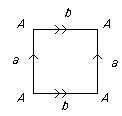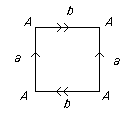Course MT4521 Geometry and topology
The Euler Characteristic
The Euler Characteristic is something which generalises Euler's observation of 1751 (in fact already noted by Descartes in 1639) that on "triangulating" a sphere into F regions, E edges and V vertices one has V - E + F = 2.
If one triangulates any surface then χ = V - E + F is a number which does not depend on how the triangulation is done. This is called the Euler Characteristic.
Examples
- χ(Torus) = 0

For example we can split up the torus into "regions" (homeomorphic to discs) with F = 2, E = 4, V = 2 or even more efficiently as  with F = 1, E = 2, V = 1
with F = 1, E = 2, V = 1
- χ(Projective plane) = 1
The planar model with edge word a2 gives a triangulation with F = 1, E = 1, V = 1
- χ(Klein bottle) = 0
The model  gives a triangulation with F = 1, E = 2, V = 1
gives a triangulation with F = 1, E = 2, V = 1
Theorem
χ(S1 # S2) = χ(S1) + χ(S2) - 2
Proof
Join S1 and S2 by removing an n-gon from each and matching vertices around the edge.
Then: V(S1 # S2) = V(S1) + V(S2) - n,
E(S1 # S2) = E(S1) + E(S2) - n,
F(S1 # S2) = F(S1) + F(S2) - 2
and so χ(S1 # S2) = χ(S1) + χ(S2) - 2.
Corollary
For the join of n tori we have χ = -2(n - 1) and for the join of n Projective planes we have χ = -(n - 2).
Proof
Use induction and χ(T) = 0, χ(P) = 1.
So if we could recognise whether a surface could be written as a product of tori or of projective planes, the Euler characteristic would be enough to classify it.
Definition
If when we carry a direction around any loop in a surface we always get a consistent direction the surface is called orientable.
Examples
- A sphere and any join of tori are orientable.
Proof
The direction of an "outward-pointing normal" can be used to define the direction.
- A Möbius band is not orientable.
Proof
Carry a direction around the curve "in the middle of the band". (A normal at a point would come back pointing the opposite way after going round once.)
- A Projective plane or any join of projective planes is not orientable.
Proof
These all contain a Möbius band.
- Any surface whose planar model contains an edge which is identified with itself rather than its inverse is not orientable.
Proof
Cut a strip out of the model with ends on the identified edge and you have a Möbius band.
JOC February 2010

 with F = 1, E = 2, V = 1
with F = 1, E = 2, V = 1 gives a triangulation with F = 1, E = 2, V = 1
gives a triangulation with F = 1, E = 2, V = 1